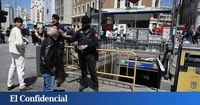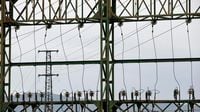On April 28, 2025, chaos erupted in Madrid as a widespread power outage paralyzed the city, disrupting transportation and leaving thousands stranded. The incident began shortly after noon when José Vicente de los Mozos, president of Ifema and CEO of Indra, was leaving a press conference at the Ifema fairgrounds, a massive venue covering 200,000 square meters, when the lights went out.
Within moments, the Madrid subway system was suspended, traffic signals ceased to function, and electronic payment systems failed, leaving many unable to pay for services. The abrupt blackout caught residents and visitors off guard, leading to a scene of confusion and desperation throughout the city.
According to reports, firefighters in Madrid responded to 210 incidents, primarily rescuing individuals trapped in elevators, while emergency medical services (Samur) handled 167 cases, mainly related to respiratory issues and anxiety attacks. The situation escalated quickly, with people attempting to navigate the chaotic streets, where traffic flowed erratically without traffic lights.
“It looks like the press conference is over,” one onlooker remarked as officials scrambled to open the fairground's doors and manage the situation. With no public transportation available, many citizens resorted to hitchhiking to get home, while tourists struggled to understand the unfolding crisis.
As the day progressed, the mayor of Madrid, José Luis Martínez-Almeida, announced the closure of the M-30 tunnels to alleviate traffic congestion. Meanwhile, President Isabel Díaz Ayuso called for military intervention to assist with the crisis. The M-30 highway, a vital artery for the city, became a monumental traffic jam by 3 PM, with cars stuck for hours.
Parents faced additional challenges as they rushed to pick up their children from schools, fearing that the streets would soon become overcrowded. Teachers at one school expressed concern for a diabetic student who could not charge their mobile phone to monitor their health, while parents worried about how to manage insulin that required refrigeration.
In a nearby supermarket, two cars blocking a lane sparked frustration among shoppers and drivers alike. The streets, usually bustling and orderly, transformed into treacherous routes, where crossing became a risky endeavor.
While the situation remained tense in the city center, the atmosphere in neighborhoods like Hortaleza was markedly different. Many residents, including a couple dressed for a hiking trip, remained oblivious to the chaos surrounding them.
As the day wore on, the lack of communication and reliable information added to the anxiety. A tourist named Luis, who was stranded at Atocha station with friends, expressed his frustration: “We have no idea what's happening. We were supposed to leave for Barcelona at 3 PM.” The station, like many others, was closed, trapping numerous travelers.
Authorities worked to manage the situation, with police deployed across the city to regulate traffic and maintain order. Despite their efforts, the absence of functioning traffic signals made it nearly impossible to restore normalcy.
In a statement on social media, Metro de Madrid confirmed that all lines were closed due to the outage, advising residents to avoid travel unless necessary. Urban buses and intercity transport were made free for the day, but congestion continued to plague the city.
As night fell, the power began to be restored in various districts of Madrid, but some areas still experienced outages. By 6:45 PM, towns like Humanes, Parla, and Torrejon de Velasco reported restored power, while other regions continued to struggle.
Red Eléctrica de España reported that they were working diligently to restore electricity across the country. However, the cause of the blackout remained unclear. President Pedro Sánchez later confirmed that a sudden loss of 15 gigawatts had triggered the blackout, a situation unprecedented in Spain.
As the government mobilized resources to address the crisis, the Minister of Transport, Óscar Puente, confirmed that rail services could not be restored that day. Efforts were focused on evacuating passengers from trapped trains, with many left stranded overnight.
Meanwhile, the chaos extended beyond Madrid, affecting cities across Spain and even reaching parts of Portugal. The situation prompted an emergency response from various government agencies, including the activation of emergency plans in multiple regions.
In the aftermath of the blackout, citizens expressed their concerns and frustrations on social media. Some speculated about the potential causes, including the possibility of a cyberattack, while others simply sought information on when normal services would resume.
As the night progressed, the government continued to provide updates, assuring citizens that they were working tirelessly to restore order and electricity. However, the uncertainty left many anxious about the future, especially as they navigated the aftermath of a day filled with chaos.
By the early hours of April 29, power had been restored to most of Madrid, but sporadic outages continued to affect certain areas. The government urged residents to remain cautious and avoid unnecessary travel as they worked to fully resolve the situation.
The events of April 28, 2025, will likely be remembered as a day of unprecedented disruption in Spain, raising questions about the resilience of critical infrastructure and the preparedness of emergency services in the face of such challenges.





